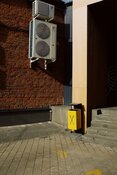Red Cat Holdings Inc. (RCAT:NASDAQ) is a military technology company that integrates robotic hardware and software to provide critical situational awareness and actionable intelligence to on-the-ground warfighters and battlefield commanders.
The company couches its mission as "enhancing the effectiveness and safety of military operations domestically and globally" so that teams who deploy its hardware can "Dominate the Night™."
The company is most widely known for its Teal 2 platform, a small unmanned system with the highest resolution imaging for nighttime operations. It also operates Skypersonic, a leading provider of unmanned aircraft specifically designed for infrastructure analysis use in interior spaces and other dangerous environments.
The Catalyst: New Tech To Meet New Market Needs
On June 20, Red Cat Holdings announced that it had completed the second phase of an "artificial intelligence and computer-vision partnership" with Australia-based Athena AI.
Although the partnership was first announced as a Teal 2 partner in March, by processing video that the Teal 2's thermal-imaging sensor recorded during a nighttime test flight, Athena's technology has now successfully performed target recognition and battle tracking for the first time.
This expanded capability allows commanders fast decision-making on the battlefield with artificial intelligence assistance.
"Nighttime computer-vision capability is a Teal 2 add-on we support for users who need high-value data at night," explained George Matus, founder and CEO of the Teal Drones subsidiary. "The images and insights that Athena's technology deliver are outstanding. Athena's battle-tracking capabilities and artificial intelligence, combined with Teal's best-in-class drone, give warfighters the unfair advantage."
MarketWatch recently projected that the global market for military drones would "reach US$19,002.47 million by 2031 from US$10,193.83 Million in 2022 at a robust CAGR of 7.49% during the forecast period."
Athena, an AI-enabled military decision-support concern, has licensed to Red Cat its proprietary computer-vision architecture, which allows high-speed tracking of objects and in-depth data exploitation at slower speeds.
The enhanced tech can identify weapons, humans, and other targets at night, as well as Identification Friend or Foe (IFF) markers, such as Cyalume HALOs and IR beacons.
"Unlike a lot of other drones in the sUAS quad space that aren't MISB-compliant, the Teal 2's KLV metadata unlocks the full decision-suite support of Athena AI," said Athena CEO Stephen Bornstein. "This combination of a nighttime sUAS with live-vehicle metadata allows for real-time situational awareness to support battle tracking, common operational picture (COP) at higher echelons of command, and accurate targeting."
Officially launched in April, the Teal 2 is the first drone platform to be equipped with Teledyne FLIR's new Hadron 640R sensor, providing end users with the highest resolution thermal imaging available in a small form factor.
Why This Sector? Growing Military Reliance on Unmanned Platforms
Red Cat's technology is maturing to a market-ready, scalable production state just as unmanned aerial platforms are proliferating as the best cost-to-value option for militaries around the world. Analysts around the world are recognizing this, and highlighting drone production as a high-growth market in the coming decade.
MarketWatch recently projected that the global market for military drones would "reach US$19,002.47 million by 2031 from US$10,193.83 Million in 2022 at a robust CAGR of 7.49% during the forecast period."
Vantage Market Research projects that the "Global Military Drone Market is valued at US$14.51 billion in 2023 and is projected to reach a value of US$34.91 billion by 2030 at a CAGR of 11.60% over the forecast period."
The same report explained that "The top 5 countries that are expected to invest heavily in military drones in the coming years are the United States, China, Russia, Israel, and the United Kingdom. The United States is expected to lead the market."
"The U.S. Department of Defense has planned to acquire more than 1,000 drones by 2025 [and] has allocated a budget of US$7.7 billion for drones in 2021. Globally Over 3,427 Units of Military Drones Sold in 2022."
Vantage Market Research projects that the "Global Military Drone Market is valued at US$14.51 billion in 2023 and is projected to reach a value of US$34.91 billion by 2030 at a CAGR of 11.60% over the forecast period."
In addition, the Pentagon just recently announced that it had massively overestimated how much military aid it had already provided to Ukraine in its ongoing conflict with Russia. This miscalculation of some US$6.2 billion reveals that there's still considerable space in that support budget to accommodate a large fleet of Teal 2 drones.
Why This Company? Great Government Relationships
It only took Red Cat one day after the announcement of the Teal 2's successful integration with Athena's AI to secure clearance from the U.S. Department of Defense (DoD) to be designated as a Blue UAS.
The Blue UAS Cleared List is a select group of DoD-approved drones for government users. According to the DoD, these drones "are NDAA compliant, validated as cyber-secure and safe to fly, and are available for government purchase and operation."
Drones in the Teal 2 line is the second offering from Teal Drones to pass the rigorous testing required for Blue UAS clearance. Teal's legacy drone platform, the Golden Eagle, is also on the cleared list, which currently includes fewer than 20 models of drones from various manufacturers.
Blue UAS is an initiative of the Defense Innovation Unit (DIU), the only DoD organization focused on accelerating the adoption of commercial and dual-use technology to rapidly solve operational challenges.
On February 13, well before any of this past week's bullish news, Technical Analyst Clive Maund opined that "Red Cat has done well since it was recommended on the site on the 10 – 11th January, adding over 40% at one point a week ago, when it spiked dramatically higher on big volume."
"Blue UAS clearance is a high bar to reach . . . because of the extensive vetting process," said CEO Matus. "With this certification, all our customers — military, government, and commercial — can be confident that the Teal 2 meets the highest standards for cybersecurity, safety, and operation."
"Blue UAS certification opens the door to greater opportunities for Teal 2," Matus continues. "We can now fill orders that were contingent on certification, and in addition to orders from the U.S. government, we know that governments of allied nations are also more likely to purchase Blue UAS-approved drones."
The company is already comfortable selling to other arms of the U.S. government. On January 25 the United States Department of Interior authorized the Bureau of Land Management to acquire two Teal Golden Eagle drones for use in resource management and fire control coordination roles. That authorization includes another prospective fourteen purchases in the future for a total fleet size of 16.
Red Cat is also engaged in an ongoing US$90 million contract providing drones to U.S. Customs and Border Patrol.
Why Now? Current Price Doesn't Consider Sales Upside
On February 13, well before any of this past week's bullish news, Technical Analyst Clive Maund opined that "Red Cat has done well since it was recommended on the site on the 10 – 11th January, adding over 40% at one point a week ago, when it spiked dramatically higher on big volume."
"While I have not been able to get to the bottom of the reasons for that move, I believe it was due to the possibility of the company winning a big order from the government, and it makes sense that this should happen at some point, given the nature of the company's products. In any event, this action certainly looks bullish, and it gives us an inkling of what is likely to happen if it really does win some big orders, as it seems inevitable at some point."
"From the standpoint of timing any new buying, this looks like a good point to buy or add to positions . . . We, therefore, stay long, and this is thought to be a good point to buy or add."
Ownership and Share Structure
According to Red Cat, 37.27% of the stock is held by management and insiders. Reuters notes that CEO Jeff Thompson owns 22.88%, with 12.46 million shares. CEO of Fat Shark RC Vision Systems Gregory Ralph French has 7.40%, with 4.03 million. COO Allan Thomas Evans has 2.13%, with 1.16 million. Director Nicholas Liuzza has 1.48%, with 0.81 million. CFO Joseph Hernon has 0.86%, with 0.47 million. Ceo of Teal Drones, George Matus, has 0.60%, with 0.32 million, and Director Joseph Freedman has 0.40%, with 0.22 million.
9.01% is with institutional investors. The Vanguard Group Inc. has 2.34%, with 1.28 million shares. Pelion Venture Partners has 1.65%, with 0.90 million. BlackRock Institutional Trust has 0.62%, with 0.34 million, and Geode Capital Management LLC has 0.50%, with 0.27 million.
The rest is in retail.
Red Cat Holdings has a market cap of US$65 million, with 54,317,718 shares outstanding, alongside 1,539,999 warrants and 3,634,142 options.
The company had US$32.9 million in cash holdings as of 10/30/22.
| Want to be the first to know about interesting Special Situations and Technology investment ideas? Sign up to receive the FREE Streetwise Reports' newsletter. | Subscribe |
Important Disclosures:
- As of the date of this article, officers and/or employees of Streetwise Reports LLC (including members of their household) own securities of Red Cat Holdings Inc.
- Owen Ferguson wrote this article for Streetwise Reports LLC and provides services to Streetwise Reports as an independent contractor.
- The article does not constitute investment advice. Each reader is encouraged to consult with his or her individual financial professional and any action a reader takes as a result of information presented here is his or her own responsibility. By opening this page, each reader accepts and agrees to Streetwise Reports' terms of use and full legal disclaimer. This article is not a solicitation for investment. Streetwise Reports does not render general or specific investment advice and the information on Streetwise Reports should not be considered a recommendation to buy or sell any security. Streetwise Reports does not endorse or recommend the business, products, services or securities of any company mentioned on Streetwise Reports.
For additional disclosures, please click here.














































